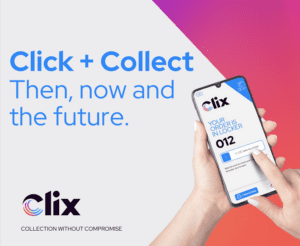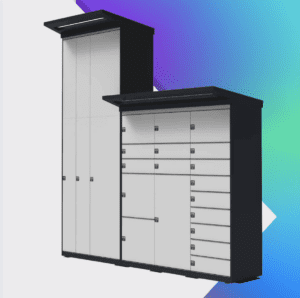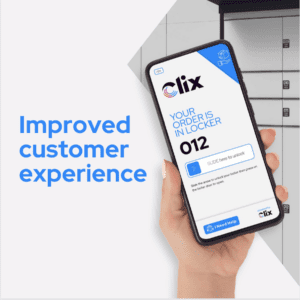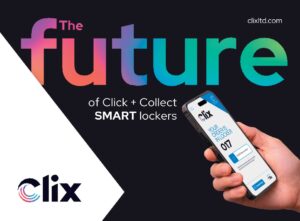Click + Collect:
Then, now and the future
 Click + Collect is a term that most people are familiar with. It does what it says on the tin, right? The customer clicks on a website to buy an item, then travels to a store to collect it. It sounds so easy, but it can be fraught with issues for both the retailer and the customer, particularly as the retail landscape continues to evolve.
Click + Collect is a term that most people are familiar with. It does what it says on the tin, right? The customer clicks on a website to buy an item, then travels to a store to collect it. It sounds so easy, but it can be fraught with issues for both the retailer and the customer, particularly as the retail landscape continues to evolve.
In this blog, we’ll go right back to basics, exploring the evolution of Click + Collect and how it’s currently facilitated, the pain points it can create and the future-proof solutions that all retailers should be considering when planning their BOPIS strategy. If you’re on the fence about where to go with your Click + Collect offering, you’ve come to the right place.
What is Click + Collect?
Click + Collect describes the process whereby a product is purchased online then picked up by the customer at a designated location, most often in the same retailer’s bricks-and-mortar store. The phrase was coined in the early 2000s by UK retailer, Argos, and is now widely used as the catch-all phrase for the process of BOPIS.
The strategy allows retailers to offer omnichannel shopping without drastically changing their fundamental business model. Bridging the gap between online and physical stores, it has become one of the industry’s most successful business models, but its evolution is far from over, and events of the past three years have rapidly accelerated its growth.
Why does Click + Collect exist?
The existence of Click + Collect is ultimately due to the demands of the modern consumer. The two main factors driving buyer behaviour are speed and convenience. People want to buy a product online and have it in their hands as quickly as possible or at a time that is convenient to them, instead of paying for shipping or waiting for their delivery to arrive.
When physical stores were ordered to close during the Covid-19 pandemic, Click + Collect became the only option for consumers in getting hold of certain products. Retailers and customers were both forced to adopt the process, so much so that even when it was no longer mandatory, consumers continued to choose the service for its ultimate convenience.
Is Click + Collect here to stay?
In a word, yes. Buyer behaviour has been irreversibly changed and customer demands continue to evolve. Hybrid shopping, where online and offline shopping channels merge into one extended experience for the customer, is becoming the norm and retailers must embrace the potential of everything that this offers to stay ahead of the curve.
In terms of the statistics, the numbers speak for themselves. Click + Collect orders are projected to be worth over £45 billion by 2026. Over 15% of UK e-commerce sales will be fulfilled through Click + Collect in 2023, with an expected increase to 19% by 2026. In 2022, 41% of stores were being used as collection locations, a number that is only set to grow.
How do retailers facilitate Click + Collect?
While the concept of Click + Collect is straightforward, the method of implementation can vary greatly from business to business. Which method to choose will depend on many variables, from the space a retailer has available to the products they provide. Here are the most popular methods:
Dedicated collection desk
An in-store service desk dedicated solely to fulfilling online orders. Staff are permanently deployed to locate and handover orders as and when customers arrive.
Existing customer service point
Existing in-store locations such as tills and customer service desks double up as the Click + Collect area, with staff dealing with multiple enquiries.
Unmanned collection point
An in-store collection point incorporating a shared touchscreen. Customers enter their order number and wait for a store colleague to bring their goods out to them.
 Smart lockers
Smart lockers
Online orders are placed in collection lockers, usually opened by the customer entering a pin code or scanning a QR code on a shared screen.
Car park collection
Customer are given a time slot or asked to call a customer service number on arrival and goods are delivered to their vehicle in the car park.
Third party location
A customer buys online and chooses a collection point convenient to them offered by a third party, such as a local convenience store, post office or locker.
Retailer collaborations
Where retailers work together to share their distribution networks and offer collection from each other’s stores, for example Boden and John Lewis.
What are the benefits of Click + Collect?
The Click + Collect model may have been driven by consumer demand for speed and convenience, but it also provides a whole host of benefits for retailers:
No delivery costs
Click + Collect removes last mile delivery, saving costs on what is often the most expensive part of the fulfilment. Retailers can provide customers with the products they want without paying the fees for delivering to their home.
No delays
By removing last mile delivery that relies on third-party courier companies, retailers can avoid costly delays in shipping that often arise due to driver shortages or delivery errors. The final element of fulfilment is in the hands of the customer.
Fast order handling
With Click + Collect orders being fulfilled from store inventory, retailers are able to process and complete online orders much more quickly compared with stock being picked, packed and delivered from a centralised warehouse.
 Upselling
Upselling
Unlike ordering online for home delivery, Click + Collect drives footfall into bricks-and-mortar stores, giving retailers the opportunity to encourage further purchases with clever retail display and merchandising.
Improved customer experience
This is, of course, one of the main reasons to implement an efficient Click + Collect solution. By improving the customer experience with a fast and convenient service, retailers can promote brand loyalty and increase repeat purchases.
What are the challenges of Click + Collect?
While Click + Collect makes operational sense for many omnichannel retailers, implementation doesn’t come without its challenges:
In-store infrastructure
Retailers must consider the space and infrastructure required to facilitate Click + Collect, from collection desks to a storage solution for orders awaiting collection. Not all stores have ample space to allocate to a permanent collection facility.
Staffing inefficiencies
It is impossible for retailers to predict when those orders can be collected. This is a particular problem for desks, which must be permanently manned regardless of peaks and troughs in footfall, leading to inefficiencies in staff deployment.
Technical problems
Retailers who may be looking to improve their Click + Collect strategy can often be deterred from making improvements due to the costly, time-consuming and daunting task of integrating their existing in-store tech at trial.
Poor customer service
Oftentimes, the very reason for implementing a Click + Collect strategy becomes its downfall, with customers left frustrated by inefficient service that leaves them waiting for long periods to collect their goods.
How can we overcome these challenges?
The pandemic put unprecedented pressure on retailers to elevate Click + Collect, and solutions that worked pre-Covid are struggling to keep up with increasing demand. The industry has already seen a shift from manned collection desks towards automated smart lockers because they remove some of the pain points experienced with traditional methods.
But even smart lockers are causing issues for retailers as customer demand for Click + Collect continues. Customers may still have to queue to use shared screens or scanners at peak times and the locker structure is too uniform to accommodate any breadth and depth in product range. Retailers will need to seek out new and emerging solutions to stay ahead.
What are the options for frictionless Click + Collect?
Clix smart lockers are changing the game with unique Progressive Web App (PWA) technology that facilitates autonomous collection without shared screens or scanners. Multiple customers can collect their purchase at any one time, eliminating queues regardless of how busy it is, and retailers can redeploy staff elsewhere in the store.
The modular design moves away from a one-size-fits-all approach and towards bespoke solutions that are designed not only for specific retailers, but for the individual stores within a retailer’s estate. It’s about knowing the business needs and building a made-to-measure system to best house the product mix and integrate seamlessly with a store’s format.
The system has been developed so that it doesn’t rely on integration. Innovative and unique technology means that the Clix smart locker ecosystem can be fully trialled in-store with minimal involvement from internal IT teams. This allows retailers the opportunity to test the Clix proposition and collect valuable real-time data to prove the concept for roll-out.
Clix eliminates many of the disadvantages of traditional Click + Collect methods, maximising operational efficiency for retailers and providing their customers with the seamless, omnichannel shopping experience that they now demand. Check out the FAQs from the Retail Technology Show for more information on what Clix can do for you.
 What does the future hold?
What does the future hold?
Automated Click + Collect will continue to develop across all segments of retail, from high street to big box to trade to brands. Smart lockers will also become commonplace in the wider service-based sectors such hospitality, travel, automotive and health and fitness, using innovative solutions that incorporate emerging technology.
This might include temperature-controlled lockers for food collection, lockers with sonar technology for high-security areas in airports, outdoor lockers to enable 24-hour vehicle collection or lockers with in-built phone chargers so people can boost their battery while they work out. The possibilities are endless.
For retailers, the future of Click + Collect holds so much potential and those that embrace the opportunities available will reap the rewards for their business. For more information on how Clix can revolutionise your Click + Collect strategy now and in the future, get in touch with our team of experts today.
 What does the future hold?
What does the future hold?